Construction Law Report: JCT Standard Form, Cases, and Legislation
VerifiedAdded on 2020/04/15
|12
|3137
|52
Report
AI Summary
This report delves into the intricacies of construction law, specifically focusing on the JCT (Joint Contract Tribunal) standard form of contract, a widely used agreement in the UK for large-scale construction projects. The report examines the JCT Major Project (MP) contract, exploring its suitability for projects like the construction of a flagship hotel. It highlights crucial clauses within the JCT MP, including variations, indemnification, and payment terms, and their implications for contractual liabilities. Furthermore, the report discusses relevant UK legislation, such as the Local Democracy, Economic Development and Construction Act 2009 and the Housing Grants, Construction and Regeneration Act 1996, and analyzes landmark cases like Bridgeway Construction Ltd v Tolent Construction Ltd, Cavendish Square Holdings BV v Talal El Makdessi, and MT Hojgaard A/S v EON Climate and Renewables UK Robin Rigg East Limited. These case studies illustrate the practical application of construction law principles, particularly concerning negligence, payment disputes, and the interpretation of contract clauses. The report emphasizes the importance of understanding both contractual and tortious liabilities within construction projects to avoid potential disputes and ensure fair practices.
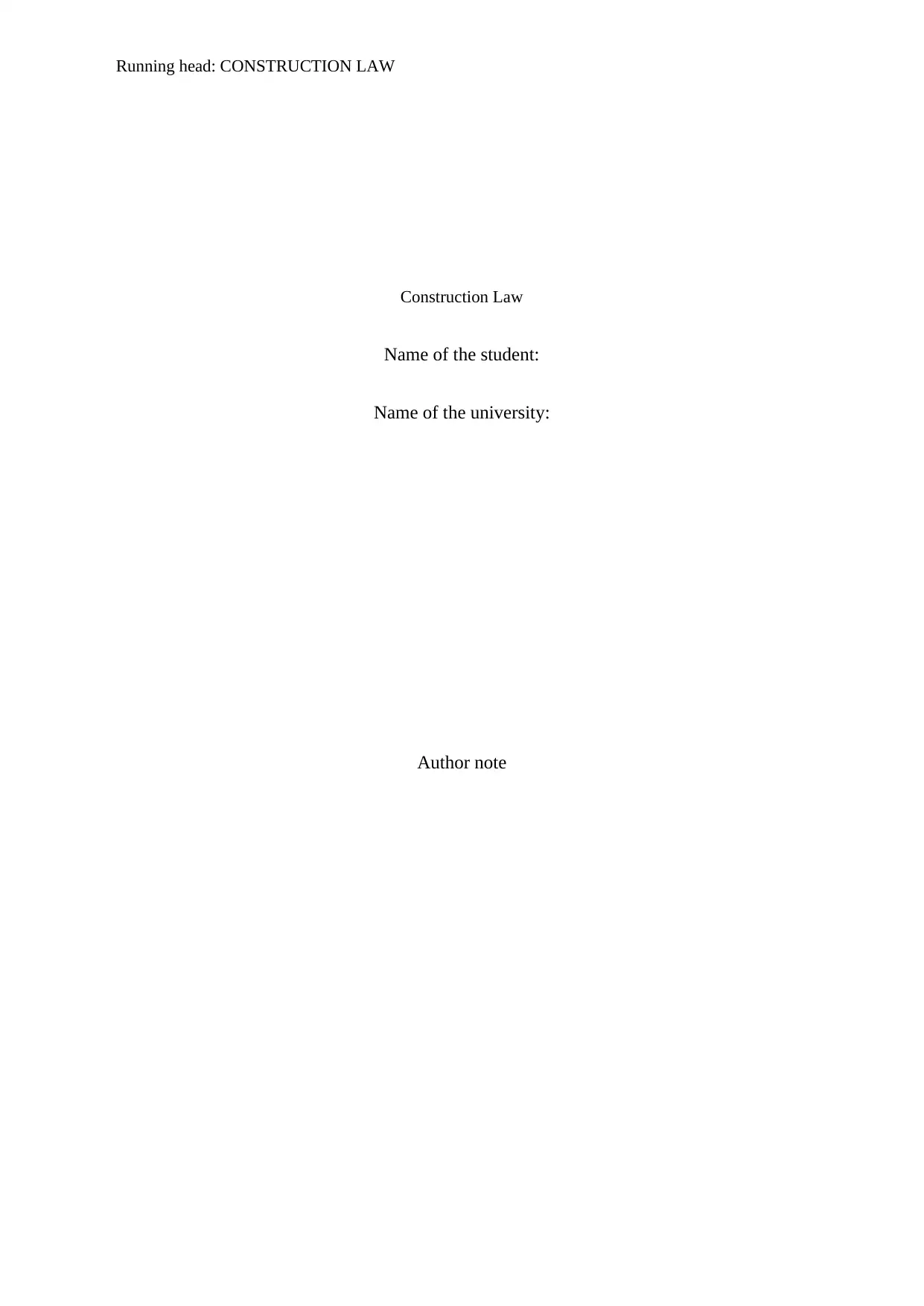
Running head: CONSTRUCTION LAW
Construction Law
Name of the student:
Name of the university:
Author note
Construction Law
Name of the student:
Name of the university:
Author note
Paraphrase This Document
Need a fresh take? Get an instant paraphrase of this document with our AI Paraphraser
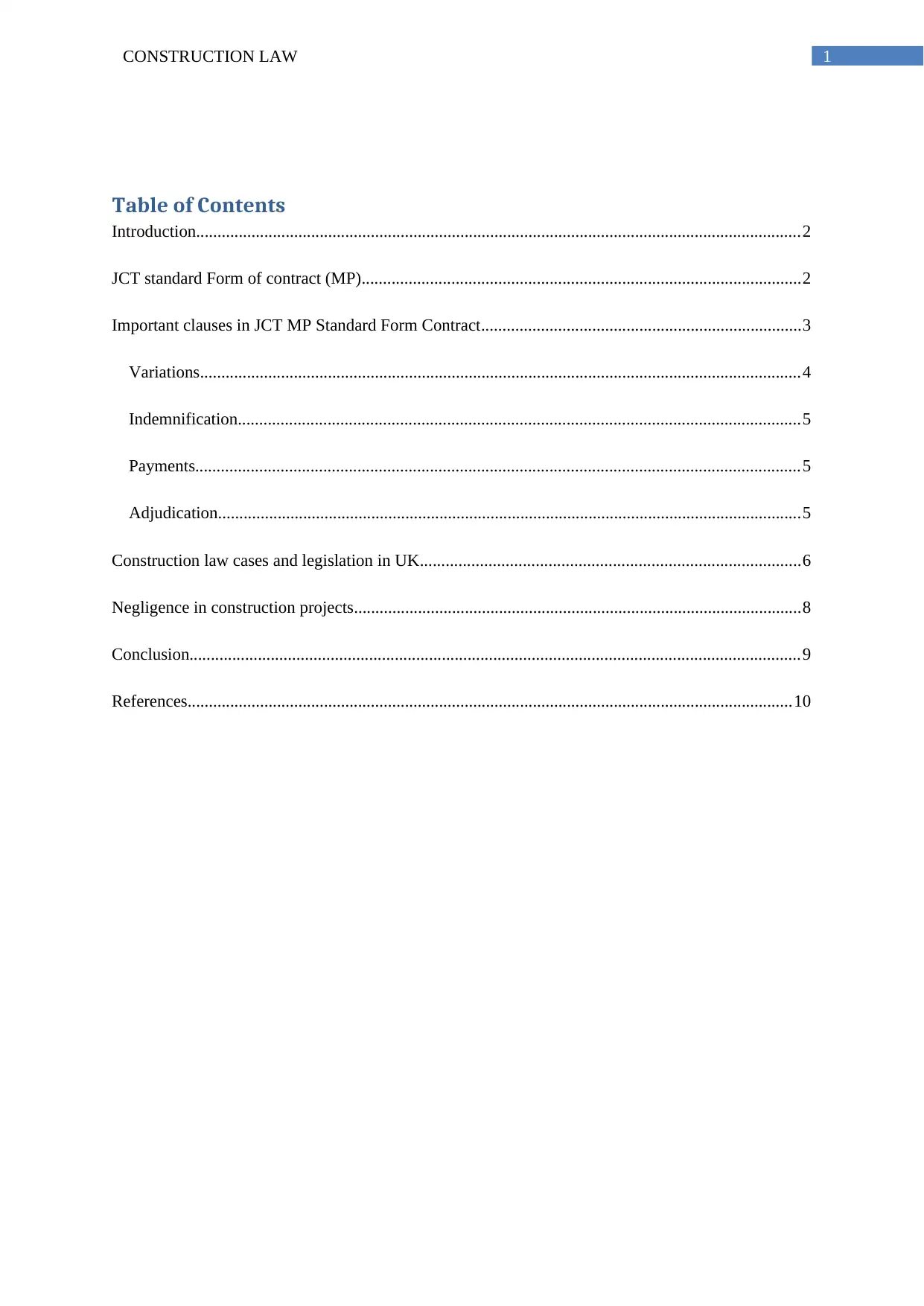
1CONSTRUCTION LAW
Table of Contents
Introduction..............................................................................................................................................2
JCT standard Form of contract (MP).......................................................................................................2
Important clauses in JCT MP Standard Form Contract...........................................................................3
Variations.............................................................................................................................................4
Indemnification....................................................................................................................................5
Payments..............................................................................................................................................5
Adjudication.........................................................................................................................................5
Construction law cases and legislation in UK.........................................................................................6
Negligence in construction projects.........................................................................................................8
Conclusion...............................................................................................................................................9
References..............................................................................................................................................10
Table of Contents
Introduction..............................................................................................................................................2
JCT standard Form of contract (MP).......................................................................................................2
Important clauses in JCT MP Standard Form Contract...........................................................................3
Variations.............................................................................................................................................4
Indemnification....................................................................................................................................5
Payments..............................................................................................................................................5
Adjudication.........................................................................................................................................5
Construction law cases and legislation in UK.........................................................................................6
Negligence in construction projects.........................................................................................................8
Conclusion...............................................................................................................................................9
References..............................................................................................................................................10
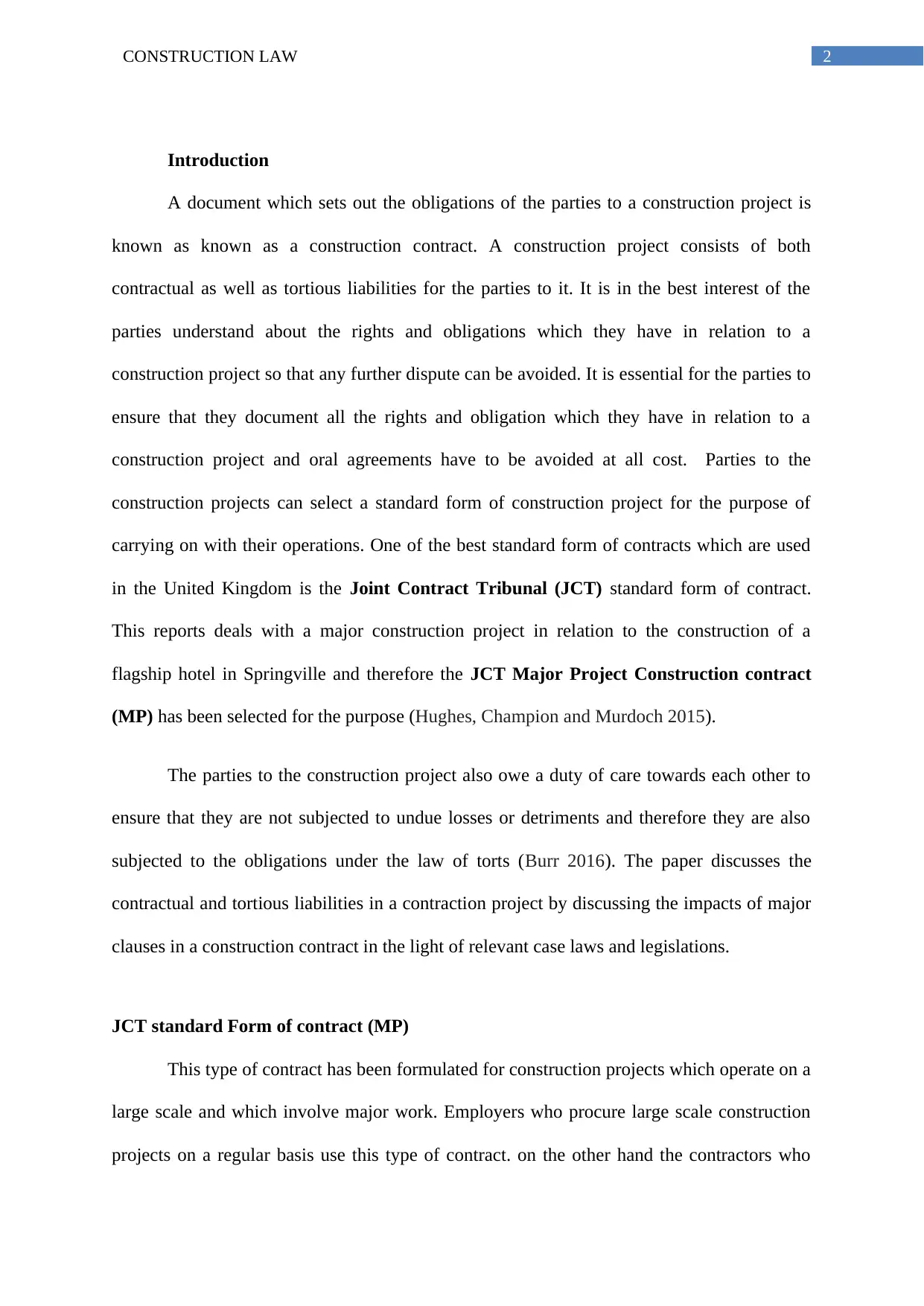
2CONSTRUCTION LAW
Introduction
A document which sets out the obligations of the parties to a construction project is
known as known as a construction contract. A construction project consists of both
contractual as well as tortious liabilities for the parties to it. It is in the best interest of the
parties understand about the rights and obligations which they have in relation to a
construction project so that any further dispute can be avoided. It is essential for the parties to
ensure that they document all the rights and obligation which they have in relation to a
construction project and oral agreements have to be avoided at all cost. Parties to the
construction projects can select a standard form of construction project for the purpose of
carrying on with their operations. One of the best standard form of contracts which are used
in the United Kingdom is the Joint Contract Tribunal (JCT) standard form of contract.
This reports deals with a major construction project in relation to the construction of a
flagship hotel in Springville and therefore the JCT Major Project Construction contract
(MP) has been selected for the purpose (Hughes, Champion and Murdoch 2015).
The parties to the construction project also owe a duty of care towards each other to
ensure that they are not subjected to undue losses or detriments and therefore they are also
subjected to the obligations under the law of torts (Burr 2016). The paper discusses the
contractual and tortious liabilities in a contraction project by discussing the impacts of major
clauses in a construction contract in the light of relevant case laws and legislations.
JCT standard Form of contract (MP)
This type of contract has been formulated for construction projects which operate on a
large scale and which involve major work. Employers who procure large scale construction
projects on a regular basis use this type of contract. on the other hand the contractors who
Introduction
A document which sets out the obligations of the parties to a construction project is
known as known as a construction contract. A construction project consists of both
contractual as well as tortious liabilities for the parties to it. It is in the best interest of the
parties understand about the rights and obligations which they have in relation to a
construction project so that any further dispute can be avoided. It is essential for the parties to
ensure that they document all the rights and obligation which they have in relation to a
construction project and oral agreements have to be avoided at all cost. Parties to the
construction projects can select a standard form of construction project for the purpose of
carrying on with their operations. One of the best standard form of contracts which are used
in the United Kingdom is the Joint Contract Tribunal (JCT) standard form of contract.
This reports deals with a major construction project in relation to the construction of a
flagship hotel in Springville and therefore the JCT Major Project Construction contract
(MP) has been selected for the purpose (Hughes, Champion and Murdoch 2015).
The parties to the construction project also owe a duty of care towards each other to
ensure that they are not subjected to undue losses or detriments and therefore they are also
subjected to the obligations under the law of torts (Burr 2016). The paper discusses the
contractual and tortious liabilities in a contraction project by discussing the impacts of major
clauses in a construction contract in the light of relevant case laws and legislations.
JCT standard Form of contract (MP)
This type of contract has been formulated for construction projects which operate on a
large scale and which involve major work. Employers who procure large scale construction
projects on a regular basis use this type of contract. on the other hand the contractors who
⊘ This is a preview!⊘
Do you want full access?
Subscribe today to unlock all pages.

Trusted by 1+ million students worldwide
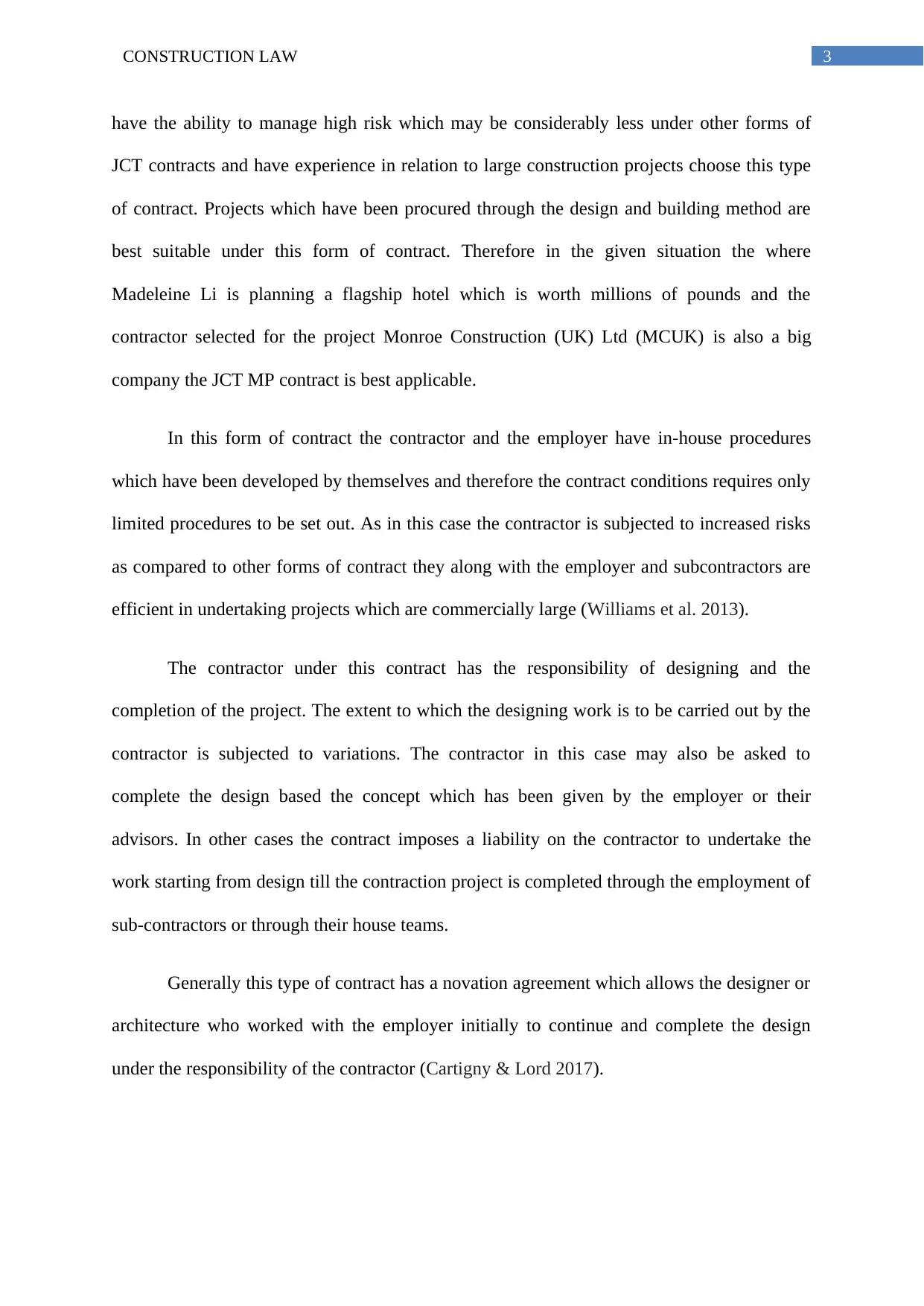
3CONSTRUCTION LAW
have the ability to manage high risk which may be considerably less under other forms of
JCT contracts and have experience in relation to large construction projects choose this type
of contract. Projects which have been procured through the design and building method are
best suitable under this form of contract. Therefore in the given situation the where
Madeleine Li is planning a flagship hotel which is worth millions of pounds and the
contractor selected for the project Monroe Construction (UK) Ltd (MCUK) is also a big
company the JCT MP contract is best applicable.
In this form of contract the contractor and the employer have in-house procedures
which have been developed by themselves and therefore the contract conditions requires only
limited procedures to be set out. As in this case the contractor is subjected to increased risks
as compared to other forms of contract they along with the employer and subcontractors are
efficient in undertaking projects which are commercially large (Williams et al. 2013).
The contractor under this contract has the responsibility of designing and the
completion of the project. The extent to which the designing work is to be carried out by the
contractor is subjected to variations. The contractor in this case may also be asked to
complete the design based the concept which has been given by the employer or their
advisors. In other cases the contract imposes a liability on the contractor to undertake the
work starting from design till the contraction project is completed through the employment of
sub-contractors or through their house teams.
Generally this type of contract has a novation agreement which allows the designer or
architecture who worked with the employer initially to continue and complete the design
under the responsibility of the contractor (Cartigny & Lord 2017).
have the ability to manage high risk which may be considerably less under other forms of
JCT contracts and have experience in relation to large construction projects choose this type
of contract. Projects which have been procured through the design and building method are
best suitable under this form of contract. Therefore in the given situation the where
Madeleine Li is planning a flagship hotel which is worth millions of pounds and the
contractor selected for the project Monroe Construction (UK) Ltd (MCUK) is also a big
company the JCT MP contract is best applicable.
In this form of contract the contractor and the employer have in-house procedures
which have been developed by themselves and therefore the contract conditions requires only
limited procedures to be set out. As in this case the contractor is subjected to increased risks
as compared to other forms of contract they along with the employer and subcontractors are
efficient in undertaking projects which are commercially large (Williams et al. 2013).
The contractor under this contract has the responsibility of designing and the
completion of the project. The extent to which the designing work is to be carried out by the
contractor is subjected to variations. The contractor in this case may also be asked to
complete the design based the concept which has been given by the employer or their
advisors. In other cases the contract imposes a liability on the contractor to undertake the
work starting from design till the contraction project is completed through the employment of
sub-contractors or through their house teams.
Generally this type of contract has a novation agreement which allows the designer or
architecture who worked with the employer initially to continue and complete the design
under the responsibility of the contractor (Cartigny & Lord 2017).
Paraphrase This Document
Need a fresh take? Get an instant paraphrase of this document with our AI Paraphraser
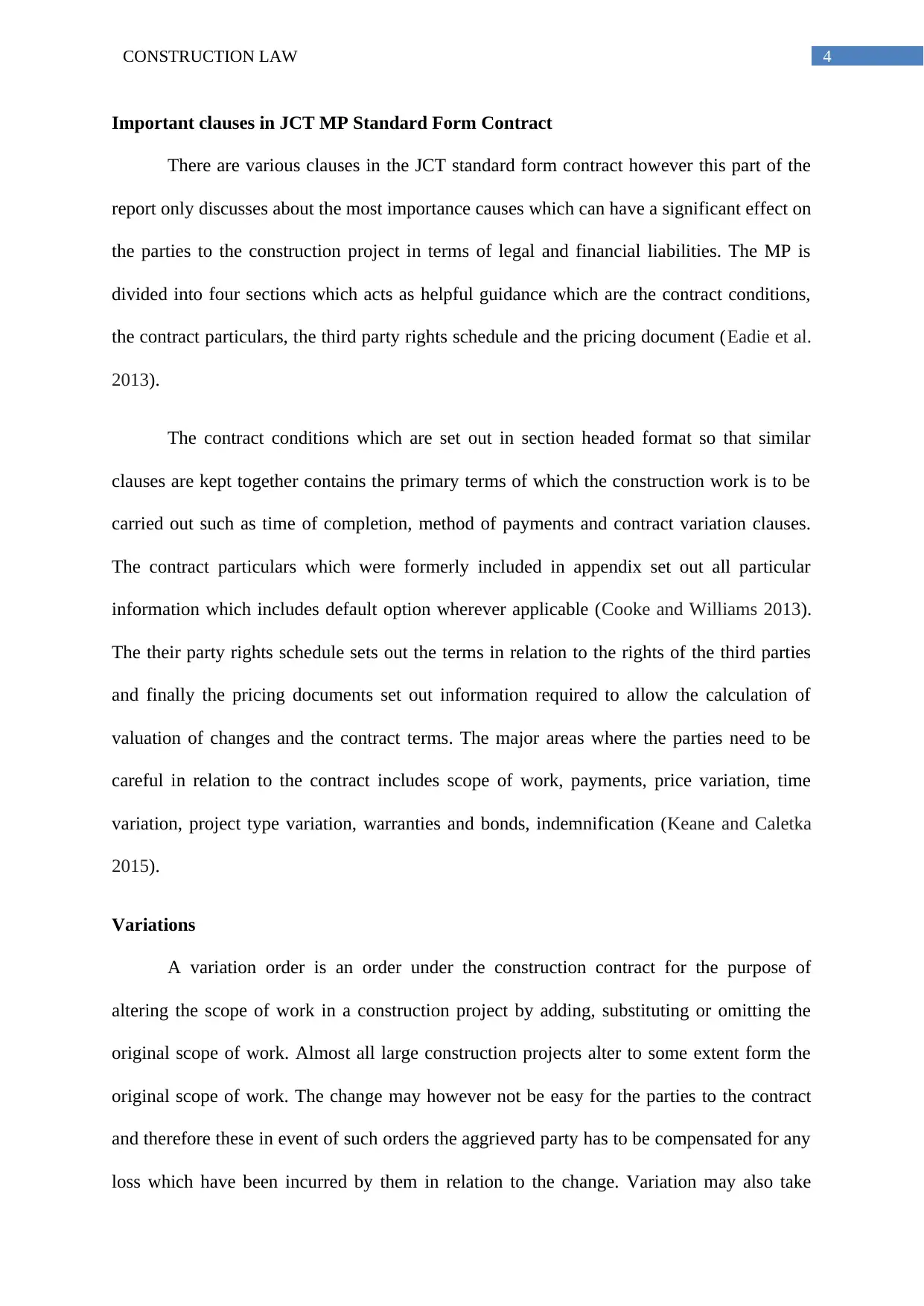
4CONSTRUCTION LAW
Important clauses in JCT MP Standard Form Contract
There are various clauses in the JCT standard form contract however this part of the
report only discusses about the most importance causes which can have a significant effect on
the parties to the construction project in terms of legal and financial liabilities. The MP is
divided into four sections which acts as helpful guidance which are the contract conditions,
the contract particulars, the third party rights schedule and the pricing document (Eadie et al.
2013).
The contract conditions which are set out in section headed format so that similar
clauses are kept together contains the primary terms of which the construction work is to be
carried out such as time of completion, method of payments and contract variation clauses.
The contract particulars which were formerly included in appendix set out all particular
information which includes default option wherever applicable (Cooke and Williams 2013).
The their party rights schedule sets out the terms in relation to the rights of the third parties
and finally the pricing documents set out information required to allow the calculation of
valuation of changes and the contract terms. The major areas where the parties need to be
careful in relation to the contract includes scope of work, payments, price variation, time
variation, project type variation, warranties and bonds, indemnification (Keane and Caletka
2015).
Variations
A variation order is an order under the construction contract for the purpose of
altering the scope of work in a construction project by adding, substituting or omitting the
original scope of work. Almost all large construction projects alter to some extent form the
original scope of work. The change may however not be easy for the parties to the contract
and therefore these in event of such orders the aggrieved party has to be compensated for any
loss which have been incurred by them in relation to the change. Variation may also take
Important clauses in JCT MP Standard Form Contract
There are various clauses in the JCT standard form contract however this part of the
report only discusses about the most importance causes which can have a significant effect on
the parties to the construction project in terms of legal and financial liabilities. The MP is
divided into four sections which acts as helpful guidance which are the contract conditions,
the contract particulars, the third party rights schedule and the pricing document (Eadie et al.
2013).
The contract conditions which are set out in section headed format so that similar
clauses are kept together contains the primary terms of which the construction work is to be
carried out such as time of completion, method of payments and contract variation clauses.
The contract particulars which were formerly included in appendix set out all particular
information which includes default option wherever applicable (Cooke and Williams 2013).
The their party rights schedule sets out the terms in relation to the rights of the third parties
and finally the pricing documents set out information required to allow the calculation of
valuation of changes and the contract terms. The major areas where the parties need to be
careful in relation to the contract includes scope of work, payments, price variation, time
variation, project type variation, warranties and bonds, indemnification (Keane and Caletka
2015).
Variations
A variation order is an order under the construction contract for the purpose of
altering the scope of work in a construction project by adding, substituting or omitting the
original scope of work. Almost all large construction projects alter to some extent form the
original scope of work. The change may however not be easy for the parties to the contract
and therefore these in event of such orders the aggrieved party has to be compensated for any
loss which have been incurred by them in relation to the change. Variation may also take
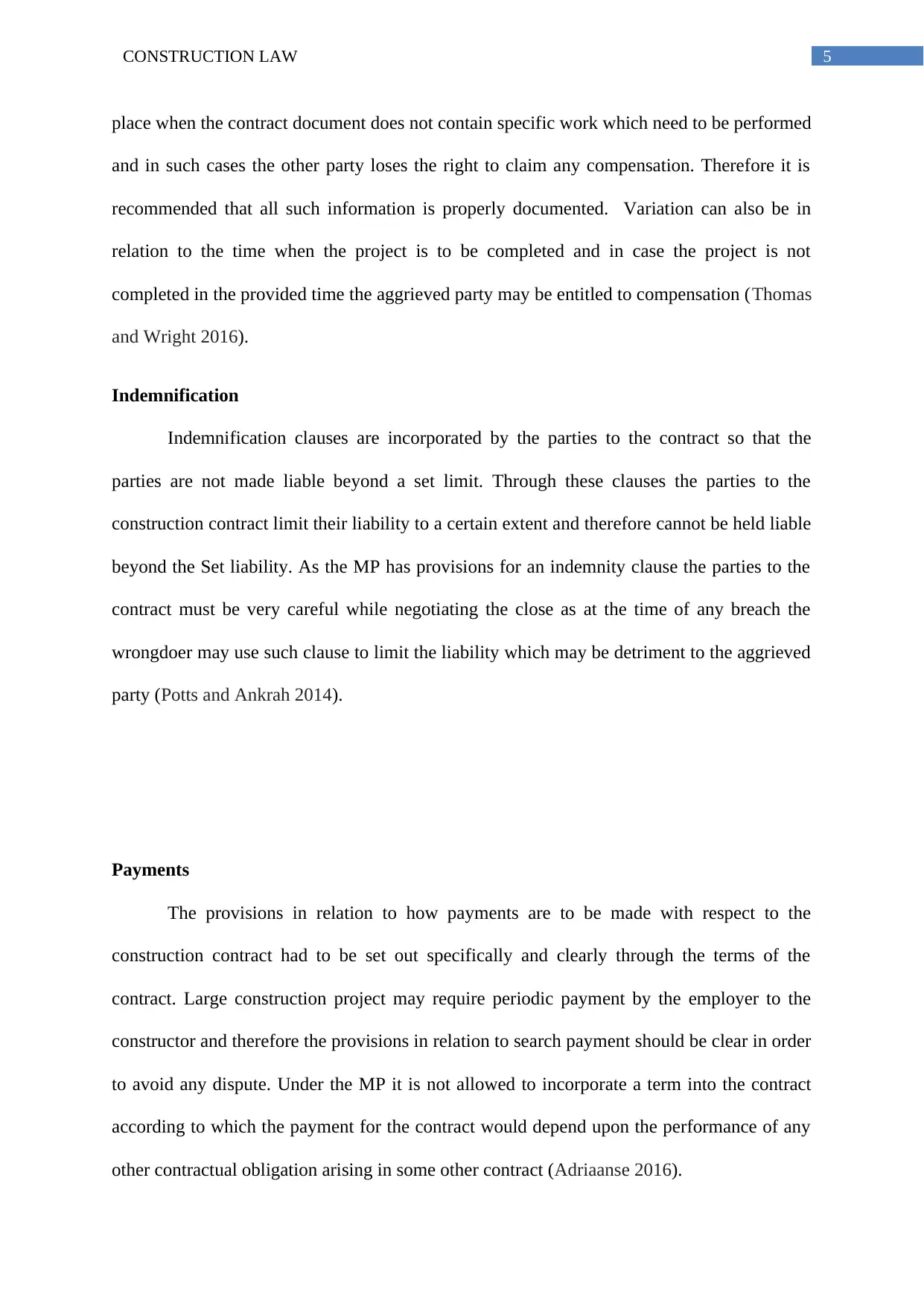
5CONSTRUCTION LAW
place when the contract document does not contain specific work which need to be performed
and in such cases the other party loses the right to claim any compensation. Therefore it is
recommended that all such information is properly documented. Variation can also be in
relation to the time when the project is to be completed and in case the project is not
completed in the provided time the aggrieved party may be entitled to compensation (Thomas
and Wright 2016).
Indemnification
Indemnification clauses are incorporated by the parties to the contract so that the
parties are not made liable beyond a set limit. Through these clauses the parties to the
construction contract limit their liability to a certain extent and therefore cannot be held liable
beyond the Set liability. As the MP has provisions for an indemnity clause the parties to the
contract must be very careful while negotiating the close as at the time of any breach the
wrongdoer may use such clause to limit the liability which may be detriment to the aggrieved
party (Potts and Ankrah 2014).
Payments
The provisions in relation to how payments are to be made with respect to the
construction contract had to be set out specifically and clearly through the terms of the
contract. Large construction project may require periodic payment by the employer to the
constructor and therefore the provisions in relation to search payment should be clear in order
to avoid any dispute. Under the MP it is not allowed to incorporate a term into the contract
according to which the payment for the contract would depend upon the performance of any
other contractual obligation arising in some other contract (Adriaanse 2016).
place when the contract document does not contain specific work which need to be performed
and in such cases the other party loses the right to claim any compensation. Therefore it is
recommended that all such information is properly documented. Variation can also be in
relation to the time when the project is to be completed and in case the project is not
completed in the provided time the aggrieved party may be entitled to compensation (Thomas
and Wright 2016).
Indemnification
Indemnification clauses are incorporated by the parties to the contract so that the
parties are not made liable beyond a set limit. Through these clauses the parties to the
construction contract limit their liability to a certain extent and therefore cannot be held liable
beyond the Set liability. As the MP has provisions for an indemnity clause the parties to the
contract must be very careful while negotiating the close as at the time of any breach the
wrongdoer may use such clause to limit the liability which may be detriment to the aggrieved
party (Potts and Ankrah 2014).
Payments
The provisions in relation to how payments are to be made with respect to the
construction contract had to be set out specifically and clearly through the terms of the
contract. Large construction project may require periodic payment by the employer to the
constructor and therefore the provisions in relation to search payment should be clear in order
to avoid any dispute. Under the MP it is not allowed to incorporate a term into the contract
according to which the payment for the contract would depend upon the performance of any
other contractual obligation arising in some other contract (Adriaanse 2016).
⊘ This is a preview!⊘
Do you want full access?
Subscribe today to unlock all pages.

Trusted by 1+ million students worldwide
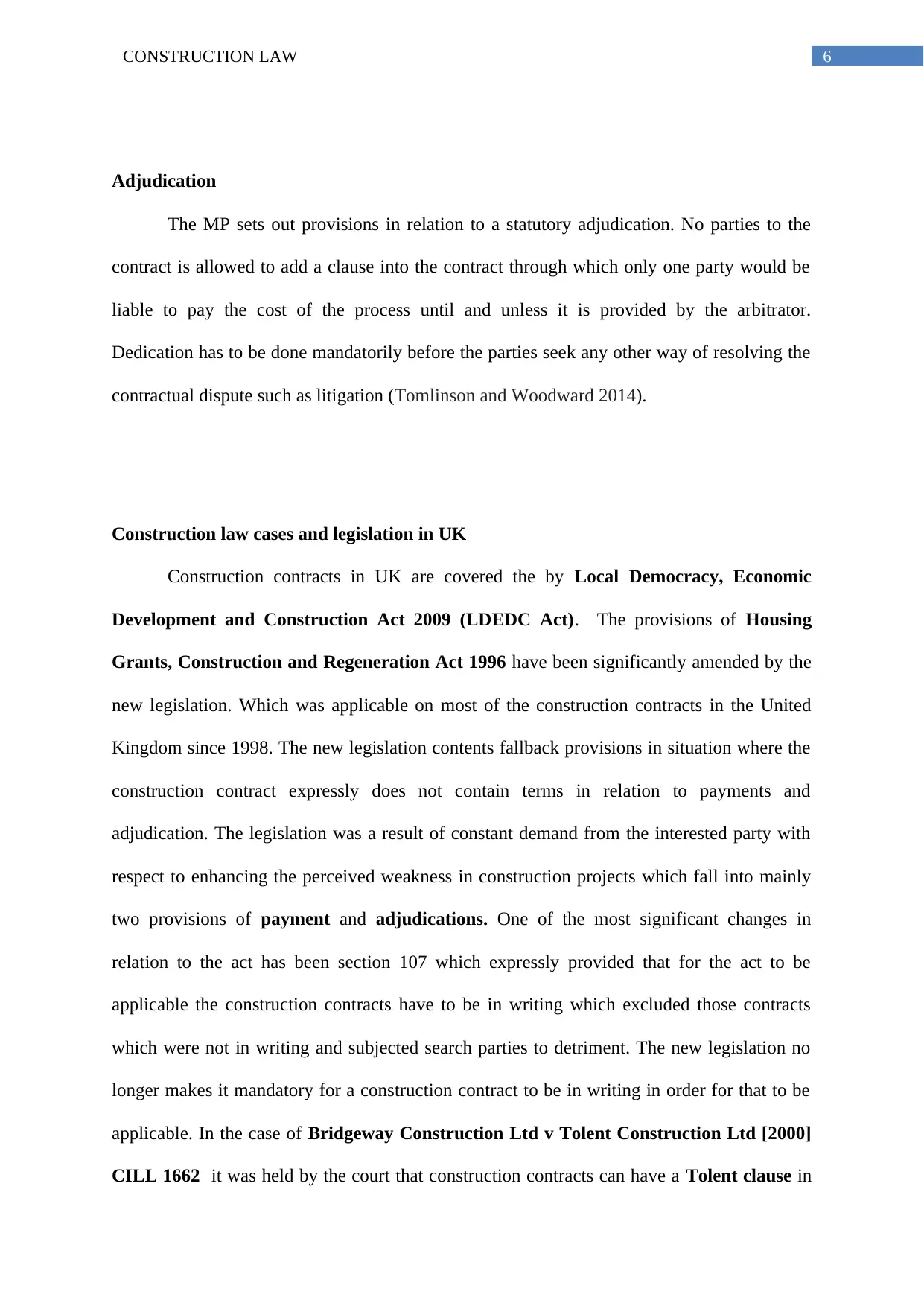
6CONSTRUCTION LAW
Adjudication
The MP sets out provisions in relation to a statutory adjudication. No parties to the
contract is allowed to add a clause into the contract through which only one party would be
liable to pay the cost of the process until and unless it is provided by the arbitrator.
Dedication has to be done mandatorily before the parties seek any other way of resolving the
contractual dispute such as litigation (Tomlinson and Woodward 2014).
Construction law cases and legislation in UK
Construction contracts in UK are covered the by Local Democracy, Economic
Development and Construction Act 2009 (LDEDC Act). The provisions of Housing
Grants, Construction and Regeneration Act 1996 have been significantly amended by the
new legislation. Which was applicable on most of the construction contracts in the United
Kingdom since 1998. The new legislation contents fallback provisions in situation where the
construction contract expressly does not contain terms in relation to payments and
adjudication. The legislation was a result of constant demand from the interested party with
respect to enhancing the perceived weakness in construction projects which fall into mainly
two provisions of payment and adjudications. One of the most significant changes in
relation to the act has been section 107 which expressly provided that for the act to be
applicable the construction contracts have to be in writing which excluded those contracts
which were not in writing and subjected search parties to detriment. The new legislation no
longer makes it mandatory for a construction contract to be in writing in order for that to be
applicable. In the case of Bridgeway Construction Ltd v Tolent Construction Ltd [2000]
CILL 1662 it was held by the court that construction contracts can have a Tolent clause in
Adjudication
The MP sets out provisions in relation to a statutory adjudication. No parties to the
contract is allowed to add a clause into the contract through which only one party would be
liable to pay the cost of the process until and unless it is provided by the arbitrator.
Dedication has to be done mandatorily before the parties seek any other way of resolving the
contractual dispute such as litigation (Tomlinson and Woodward 2014).
Construction law cases and legislation in UK
Construction contracts in UK are covered the by Local Democracy, Economic
Development and Construction Act 2009 (LDEDC Act). The provisions of Housing
Grants, Construction and Regeneration Act 1996 have been significantly amended by the
new legislation. Which was applicable on most of the construction contracts in the United
Kingdom since 1998. The new legislation contents fallback provisions in situation where the
construction contract expressly does not contain terms in relation to payments and
adjudication. The legislation was a result of constant demand from the interested party with
respect to enhancing the perceived weakness in construction projects which fall into mainly
two provisions of payment and adjudications. One of the most significant changes in
relation to the act has been section 107 which expressly provided that for the act to be
applicable the construction contracts have to be in writing which excluded those contracts
which were not in writing and subjected search parties to detriment. The new legislation no
longer makes it mandatory for a construction contract to be in writing in order for that to be
applicable. In the case of Bridgeway Construction Ltd v Tolent Construction Ltd [2000]
CILL 1662 it was held by the court that construction contracts can have a Tolent clause in
Paraphrase This Document
Need a fresh take? Get an instant paraphrase of this document with our AI Paraphraser

7CONSTRUCTION LAW
which the cost of adjudication would be borne by the party who has referred the dispute
graduation. The provisions was present to prevent a party from referring a dispute to
adjudication the new legislation to Section 108 prevents the use of the tolent clause and
render any such clause ineffective in relation to construction contracts until and unless power
is provided to the adjudicator to allocate the cost of the proceedings. The legislation
introduces provisions of statutory at dedication which means that it is binding on the parties
to the construction contract until they try to resolve the dispute through the process of
litigation.
The new legislation also address is the issue of incorrect ruling by introducing “slip
rule” which enables the adjudicator to correct typographical of clerical error in a decision.
The previous legislation supported the pay-when-paid clause however the new legislation sets
out provisions to invalidate the use of such clause. The rule had been discussed in the case of
Midland Expressway Ltd v Carillion Construction Ltd [2005] EWHC 2963 with the
court describe the process pay-when-certified, however under the new legislation the
payment provisions in a construction contract cannot be linked to the provisions of any other
contract until and unless there is an agreement between the parties for doing the construction
operation through another party rather than one of the parties to the contract. According to the
case of Cavendish Square Holdings BV v Talal El Makdessi and ParkingEye Limited v
Beavis [2015] UKSC 67 a penalty clause in a construction contract is added to prevent the
other party to the contract from breaching and provisions however the real damages are still
assessed from the actual loss which has been faced by the aggrieved party to the contract. In
the case of MT Hojgaard A/S v EON Climate and Renewables UK Robin Rigg East
Limited [2015] EWCA Civ 407 it was ruled by the court that where a contract has an
absolute warranty it is the liability of the contractor to achieve a specific result even in case
he had complied with specific design guidance where the absolute warranty in the contract
which the cost of adjudication would be borne by the party who has referred the dispute
graduation. The provisions was present to prevent a party from referring a dispute to
adjudication the new legislation to Section 108 prevents the use of the tolent clause and
render any such clause ineffective in relation to construction contracts until and unless power
is provided to the adjudicator to allocate the cost of the proceedings. The legislation
introduces provisions of statutory at dedication which means that it is binding on the parties
to the construction contract until they try to resolve the dispute through the process of
litigation.
The new legislation also address is the issue of incorrect ruling by introducing “slip
rule” which enables the adjudicator to correct typographical of clerical error in a decision.
The previous legislation supported the pay-when-paid clause however the new legislation sets
out provisions to invalidate the use of such clause. The rule had been discussed in the case of
Midland Expressway Ltd v Carillion Construction Ltd [2005] EWHC 2963 with the
court describe the process pay-when-certified, however under the new legislation the
payment provisions in a construction contract cannot be linked to the provisions of any other
contract until and unless there is an agreement between the parties for doing the construction
operation through another party rather than one of the parties to the contract. According to the
case of Cavendish Square Holdings BV v Talal El Makdessi and ParkingEye Limited v
Beavis [2015] UKSC 67 a penalty clause in a construction contract is added to prevent the
other party to the contract from breaching and provisions however the real damages are still
assessed from the actual loss which has been faced by the aggrieved party to the contract. In
the case of MT Hojgaard A/S v EON Climate and Renewables UK Robin Rigg East
Limited [2015] EWCA Civ 407 it was ruled by the court that where a contract has an
absolute warranty it is the liability of the contractor to achieve a specific result even in case
he had complied with specific design guidance where the absolute warranty in the contract
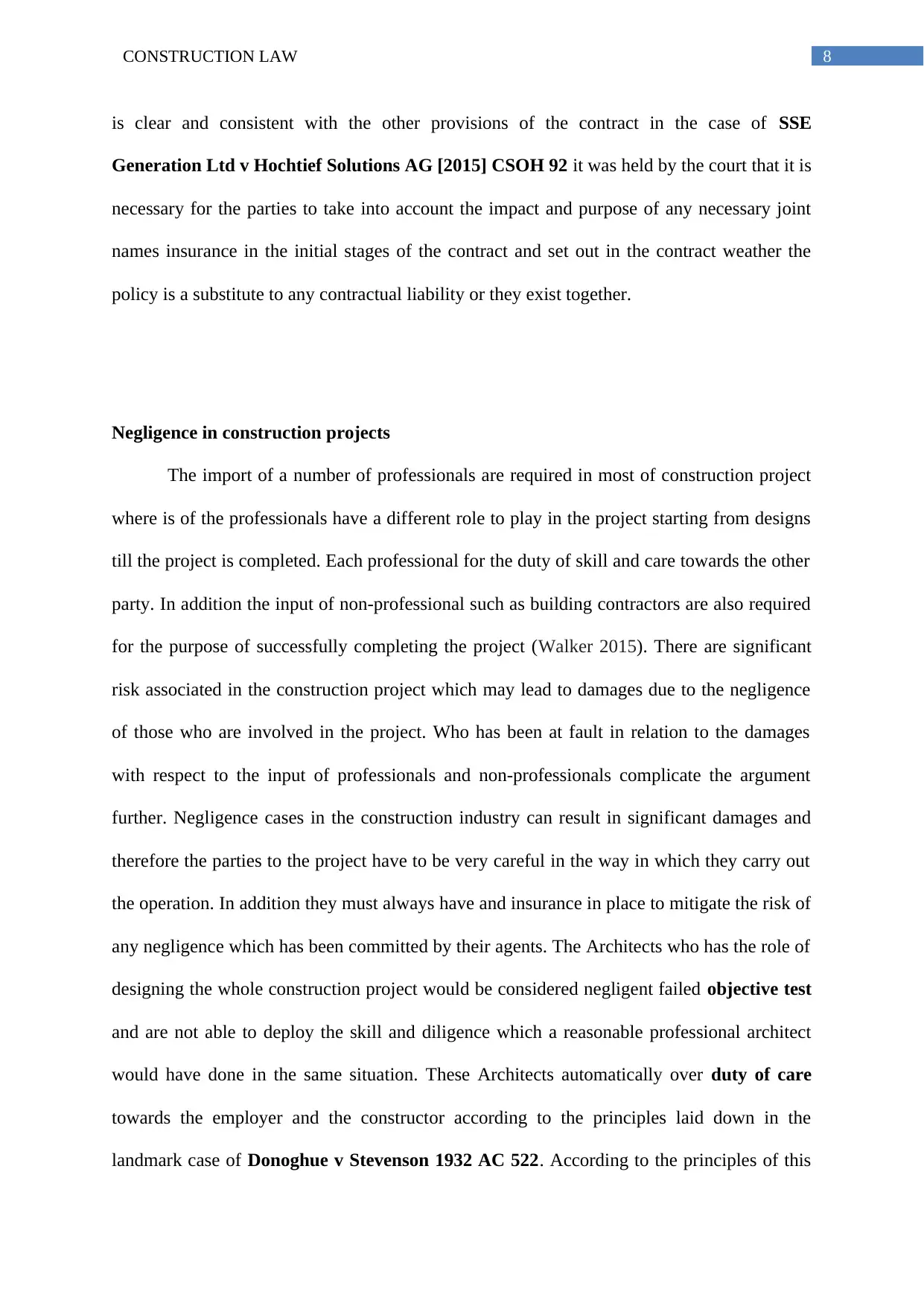
8CONSTRUCTION LAW
is clear and consistent with the other provisions of the contract in the case of SSE
Generation Ltd v Hochtief Solutions AG [2015] CSOH 92 it was held by the court that it is
necessary for the parties to take into account the impact and purpose of any necessary joint
names insurance in the initial stages of the contract and set out in the contract weather the
policy is a substitute to any contractual liability or they exist together.
Negligence in construction projects
The import of a number of professionals are required in most of construction project
where is of the professionals have a different role to play in the project starting from designs
till the project is completed. Each professional for the duty of skill and care towards the other
party. In addition the input of non-professional such as building contractors are also required
for the purpose of successfully completing the project (Walker 2015). There are significant
risk associated in the construction project which may lead to damages due to the negligence
of those who are involved in the project. Who has been at fault in relation to the damages
with respect to the input of professionals and non-professionals complicate the argument
further. Negligence cases in the construction industry can result in significant damages and
therefore the parties to the project have to be very careful in the way in which they carry out
the operation. In addition they must always have and insurance in place to mitigate the risk of
any negligence which has been committed by their agents. The Architects who has the role of
designing the whole construction project would be considered negligent failed objective test
and are not able to deploy the skill and diligence which a reasonable professional architect
would have done in the same situation. These Architects automatically over duty of care
towards the employer and the constructor according to the principles laid down in the
landmark case of Donoghue v Stevenson 1932 AC 522. According to the principles of this
is clear and consistent with the other provisions of the contract in the case of SSE
Generation Ltd v Hochtief Solutions AG [2015] CSOH 92 it was held by the court that it is
necessary for the parties to take into account the impact and purpose of any necessary joint
names insurance in the initial stages of the contract and set out in the contract weather the
policy is a substitute to any contractual liability or they exist together.
Negligence in construction projects
The import of a number of professionals are required in most of construction project
where is of the professionals have a different role to play in the project starting from designs
till the project is completed. Each professional for the duty of skill and care towards the other
party. In addition the input of non-professional such as building contractors are also required
for the purpose of successfully completing the project (Walker 2015). There are significant
risk associated in the construction project which may lead to damages due to the negligence
of those who are involved in the project. Who has been at fault in relation to the damages
with respect to the input of professionals and non-professionals complicate the argument
further. Negligence cases in the construction industry can result in significant damages and
therefore the parties to the project have to be very careful in the way in which they carry out
the operation. In addition they must always have and insurance in place to mitigate the risk of
any negligence which has been committed by their agents. The Architects who has the role of
designing the whole construction project would be considered negligent failed objective test
and are not able to deploy the skill and diligence which a reasonable professional architect
would have done in the same situation. These Architects automatically over duty of care
towards the employer and the constructor according to the principles laid down in the
landmark case of Donoghue v Stevenson 1932 AC 522. According to the principles of this
⊘ This is a preview!⊘
Do you want full access?
Subscribe today to unlock all pages.

Trusted by 1+ million students worldwide
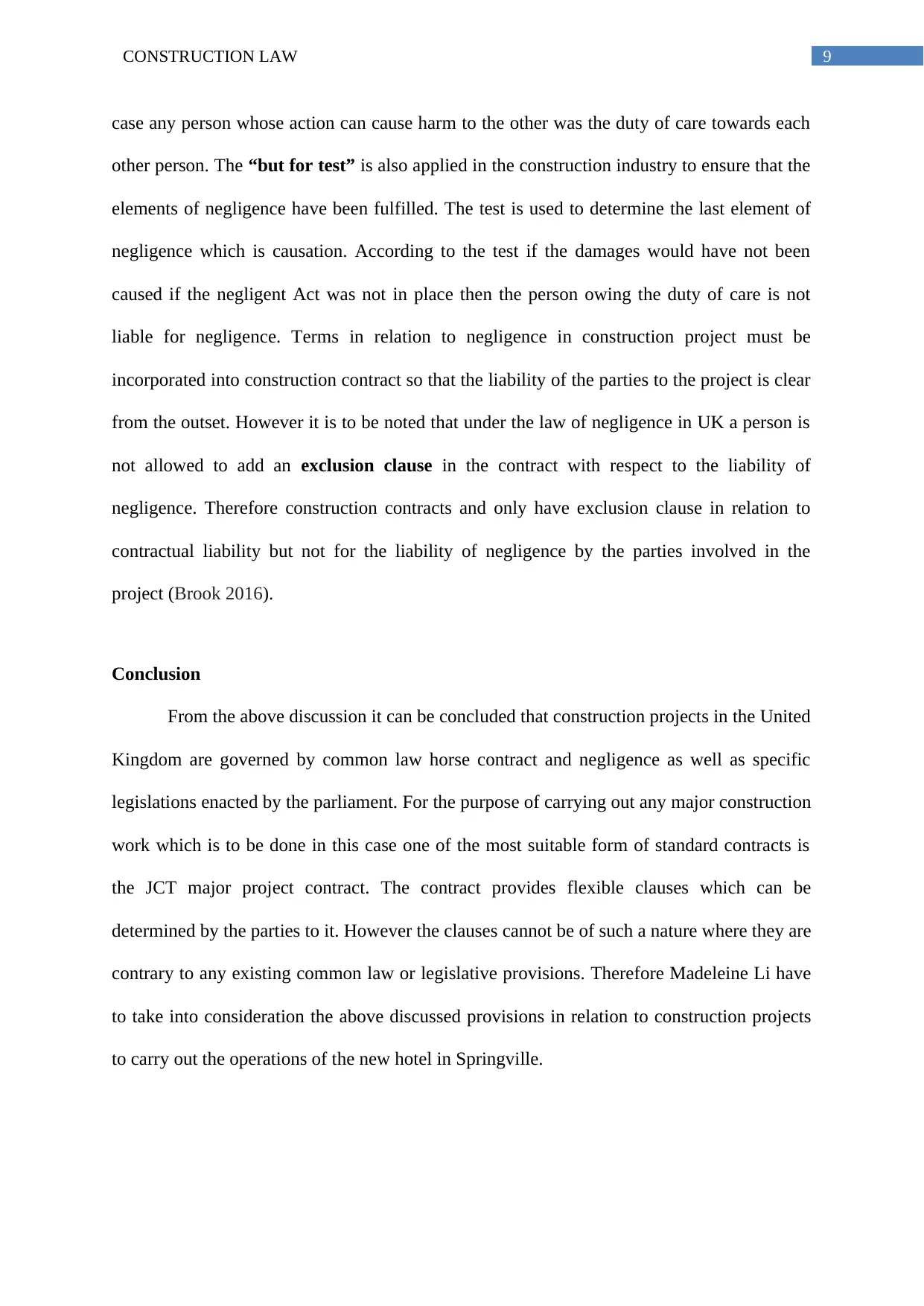
9CONSTRUCTION LAW
case any person whose action can cause harm to the other was the duty of care towards each
other person. The “but for test” is also applied in the construction industry to ensure that the
elements of negligence have been fulfilled. The test is used to determine the last element of
negligence which is causation. According to the test if the damages would have not been
caused if the negligent Act was not in place then the person owing the duty of care is not
liable for negligence. Terms in relation to negligence in construction project must be
incorporated into construction contract so that the liability of the parties to the project is clear
from the outset. However it is to be noted that under the law of negligence in UK a person is
not allowed to add an exclusion clause in the contract with respect to the liability of
negligence. Therefore construction contracts and only have exclusion clause in relation to
contractual liability but not for the liability of negligence by the parties involved in the
project (Brook 2016).
Conclusion
From the above discussion it can be concluded that construction projects in the United
Kingdom are governed by common law horse contract and negligence as well as specific
legislations enacted by the parliament. For the purpose of carrying out any major construction
work which is to be done in this case one of the most suitable form of standard contracts is
the JCT major project contract. The contract provides flexible clauses which can be
determined by the parties to it. However the clauses cannot be of such a nature where they are
contrary to any existing common law or legislative provisions. Therefore Madeleine Li have
to take into consideration the above discussed provisions in relation to construction projects
to carry out the operations of the new hotel in Springville.
case any person whose action can cause harm to the other was the duty of care towards each
other person. The “but for test” is also applied in the construction industry to ensure that the
elements of negligence have been fulfilled. The test is used to determine the last element of
negligence which is causation. According to the test if the damages would have not been
caused if the negligent Act was not in place then the person owing the duty of care is not
liable for negligence. Terms in relation to negligence in construction project must be
incorporated into construction contract so that the liability of the parties to the project is clear
from the outset. However it is to be noted that under the law of negligence in UK a person is
not allowed to add an exclusion clause in the contract with respect to the liability of
negligence. Therefore construction contracts and only have exclusion clause in relation to
contractual liability but not for the liability of negligence by the parties involved in the
project (Brook 2016).
Conclusion
From the above discussion it can be concluded that construction projects in the United
Kingdom are governed by common law horse contract and negligence as well as specific
legislations enacted by the parliament. For the purpose of carrying out any major construction
work which is to be done in this case one of the most suitable form of standard contracts is
the JCT major project contract. The contract provides flexible clauses which can be
determined by the parties to it. However the clauses cannot be of such a nature where they are
contrary to any existing common law or legislative provisions. Therefore Madeleine Li have
to take into consideration the above discussed provisions in relation to construction projects
to carry out the operations of the new hotel in Springville.
Paraphrase This Document
Need a fresh take? Get an instant paraphrase of this document with our AI Paraphraser
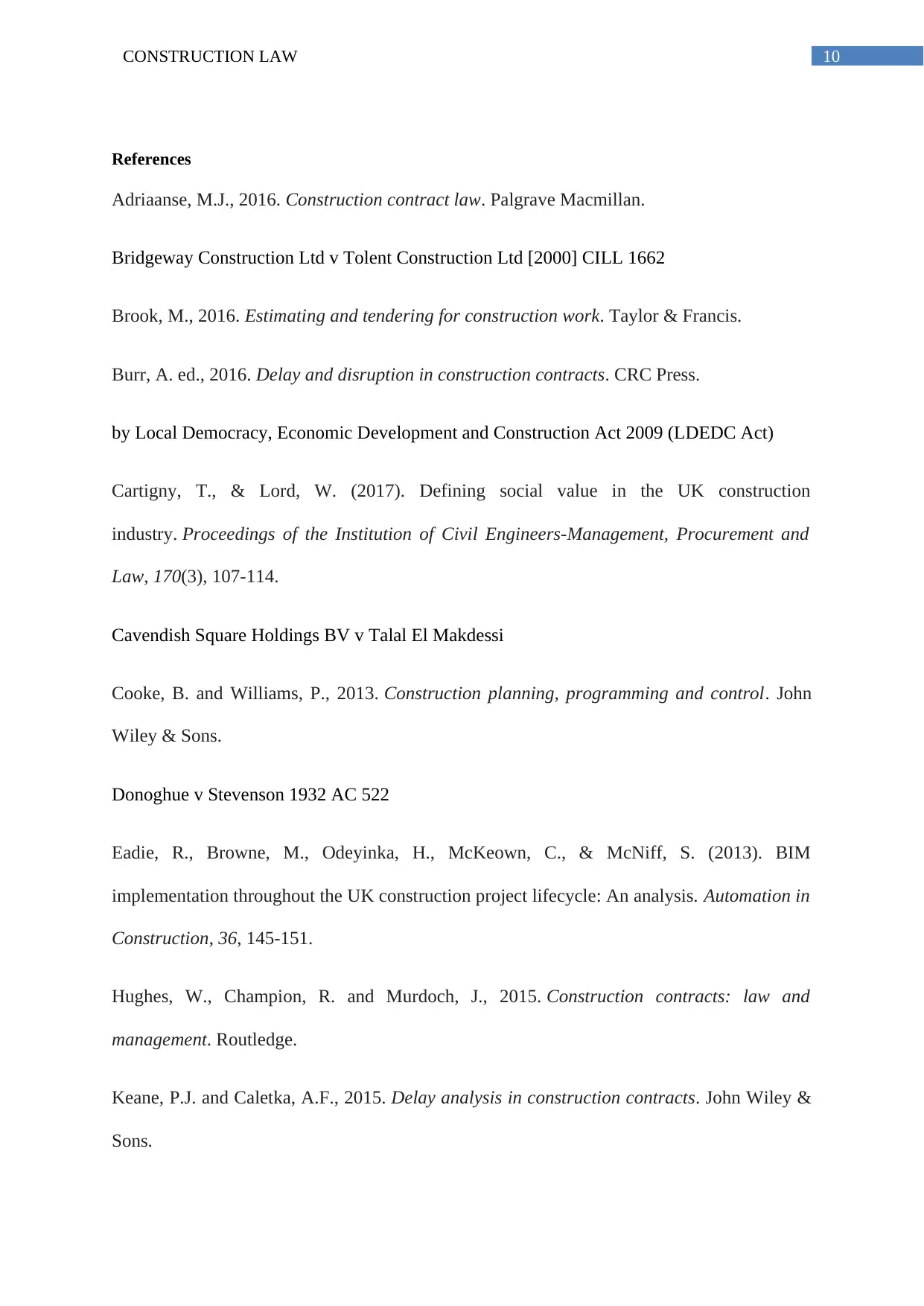
10CONSTRUCTION LAW
References
Adriaanse, M.J., 2016. Construction contract law. Palgrave Macmillan.
Bridgeway Construction Ltd v Tolent Construction Ltd [2000] CILL 1662
Brook, M., 2016. Estimating and tendering for construction work. Taylor & Francis.
Burr, A. ed., 2016. Delay and disruption in construction contracts. CRC Press.
by Local Democracy, Economic Development and Construction Act 2009 (LDEDC Act)
Cartigny, T., & Lord, W. (2017). Defining social value in the UK construction
industry. Proceedings of the Institution of Civil Engineers-Management, Procurement and
Law, 170(3), 107-114.
Cavendish Square Holdings BV v Talal El Makdessi
Cooke, B. and Williams, P., 2013. Construction planning, programming and control. John
Wiley & Sons.
Donoghue v Stevenson 1932 AC 522
Eadie, R., Browne, M., Odeyinka, H., McKeown, C., & McNiff, S. (2013). BIM
implementation throughout the UK construction project lifecycle: An analysis. Automation in
Construction, 36, 145-151.
Hughes, W., Champion, R. and Murdoch, J., 2015. Construction contracts: law and
management. Routledge.
Keane, P.J. and Caletka, A.F., 2015. Delay analysis in construction contracts. John Wiley &
Sons.
References
Adriaanse, M.J., 2016. Construction contract law. Palgrave Macmillan.
Bridgeway Construction Ltd v Tolent Construction Ltd [2000] CILL 1662
Brook, M., 2016. Estimating and tendering for construction work. Taylor & Francis.
Burr, A. ed., 2016. Delay and disruption in construction contracts. CRC Press.
by Local Democracy, Economic Development and Construction Act 2009 (LDEDC Act)
Cartigny, T., & Lord, W. (2017). Defining social value in the UK construction
industry. Proceedings of the Institution of Civil Engineers-Management, Procurement and
Law, 170(3), 107-114.
Cavendish Square Holdings BV v Talal El Makdessi
Cooke, B. and Williams, P., 2013. Construction planning, programming and control. John
Wiley & Sons.
Donoghue v Stevenson 1932 AC 522
Eadie, R., Browne, M., Odeyinka, H., McKeown, C., & McNiff, S. (2013). BIM
implementation throughout the UK construction project lifecycle: An analysis. Automation in
Construction, 36, 145-151.
Hughes, W., Champion, R. and Murdoch, J., 2015. Construction contracts: law and
management. Routledge.
Keane, P.J. and Caletka, A.F., 2015. Delay analysis in construction contracts. John Wiley &
Sons.
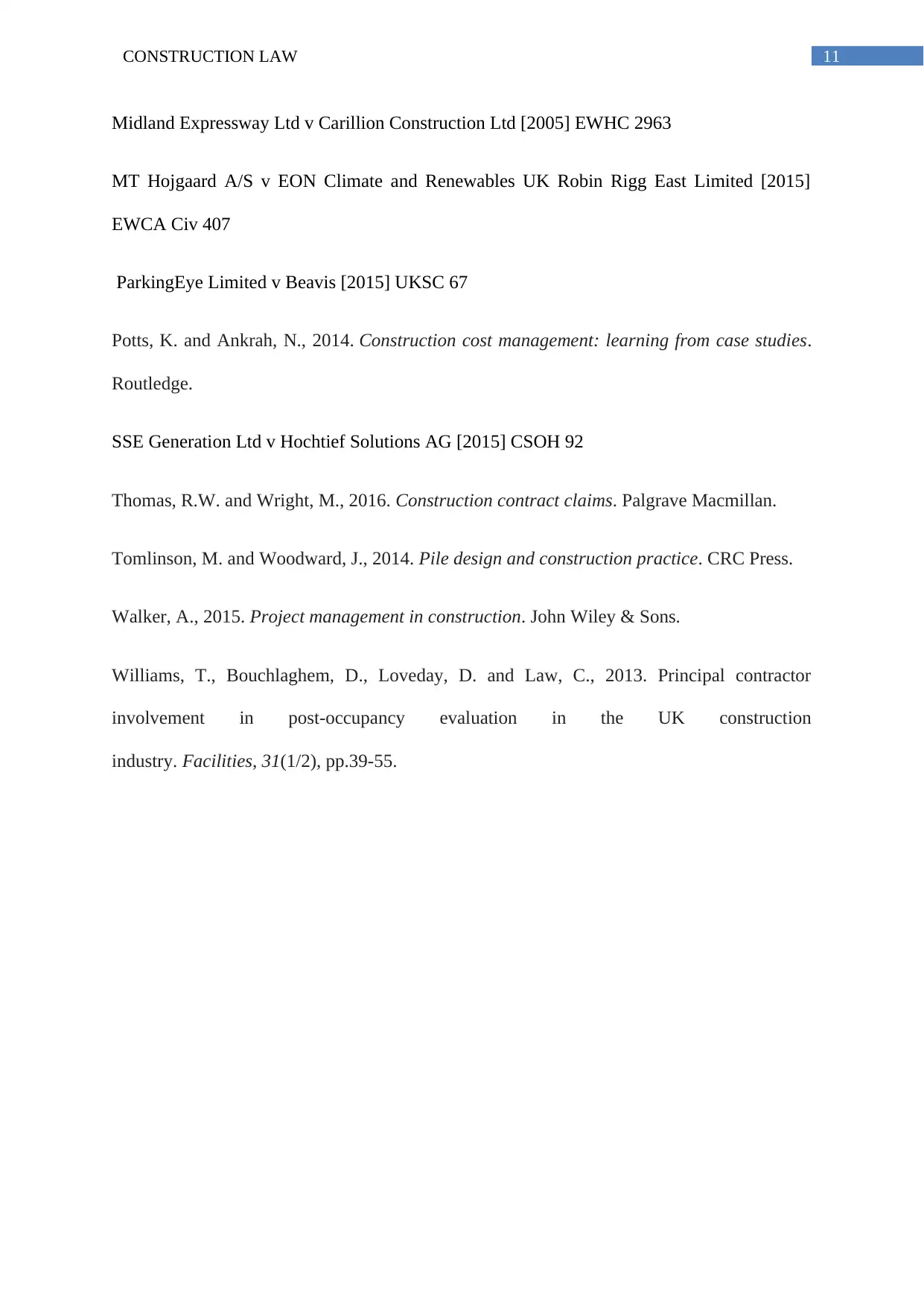
11CONSTRUCTION LAW
Midland Expressway Ltd v Carillion Construction Ltd [2005] EWHC 2963
MT Hojgaard A/S v EON Climate and Renewables UK Robin Rigg East Limited [2015]
EWCA Civ 407
ParkingEye Limited v Beavis [2015] UKSC 67
Potts, K. and Ankrah, N., 2014. Construction cost management: learning from case studies.
Routledge.
SSE Generation Ltd v Hochtief Solutions AG [2015] CSOH 92
Thomas, R.W. and Wright, M., 2016. Construction contract claims. Palgrave Macmillan.
Tomlinson, M. and Woodward, J., 2014. Pile design and construction practice. CRC Press.
Walker, A., 2015. Project management in construction. John Wiley & Sons.
Williams, T., Bouchlaghem, D., Loveday, D. and Law, C., 2013. Principal contractor
involvement in post-occupancy evaluation in the UK construction
industry. Facilities, 31(1/2), pp.39-55.
Midland Expressway Ltd v Carillion Construction Ltd [2005] EWHC 2963
MT Hojgaard A/S v EON Climate and Renewables UK Robin Rigg East Limited [2015]
EWCA Civ 407
ParkingEye Limited v Beavis [2015] UKSC 67
Potts, K. and Ankrah, N., 2014. Construction cost management: learning from case studies.
Routledge.
SSE Generation Ltd v Hochtief Solutions AG [2015] CSOH 92
Thomas, R.W. and Wright, M., 2016. Construction contract claims. Palgrave Macmillan.
Tomlinson, M. and Woodward, J., 2014. Pile design and construction practice. CRC Press.
Walker, A., 2015. Project management in construction. John Wiley & Sons.
Williams, T., Bouchlaghem, D., Loveday, D. and Law, C., 2013. Principal contractor
involvement in post-occupancy evaluation in the UK construction
industry. Facilities, 31(1/2), pp.39-55.
⊘ This is a preview!⊘
Do you want full access?
Subscribe today to unlock all pages.

Trusted by 1+ million students worldwide
1 out of 12
Related Documents
Your All-in-One AI-Powered Toolkit for Academic Success.
+13062052269
info@desklib.com
Available 24*7 on WhatsApp / Email
![[object Object]](/_next/static/media/star-bottom.7253800d.svg)
Unlock your academic potential
Copyright © 2020–2025 A2Z Services. All Rights Reserved. Developed and managed by ZUCOL.





